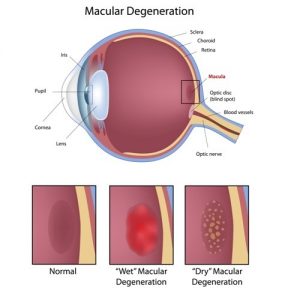Do you suspect that you’re suffering from the eye disorder named Macular Degeneration? Has anyone you know been diagnosed with this dangerous eye disease? You will find all you need to know about this eye disorder that has been the cause of blindness in a lot of people.
What is a Macular Degeneration?
Macular degeneration which is also known as age-related macular degeneration is the problem of the retina which can severely impair the vision and can lead to the loss of vision. It is a painless condition which is caused due to the deterioration of the small central portion of the retina called macula.

Macula primarily controls the visual activity, and therefore the condition causes the loss of central vision. This layer records all the images that are sent and sends them to the brain from the eye through the optic nerve. Degeneration of the Macula profoundly affects our ability to drive a vehicle, read, recognize colors and faces, watch television or use a computer and see the fine details of objects regardless of if it is near or far.
Macular degeneration is mostly seen in people aged above 50. It is the leading cause of blindness in people and has affected people more than Cataract and glaucoma. There is no distinguished cure for this condition, but laser therapy, vitamins, visual aids, and medications can help.
Types of Macular Degeneration
There are two main types of this diseases named dry and wet macular degeneration. The dry form is the more common one, but the wet form is known to cause the more severe type of vision loss.
- Dry Macular Degeneration or non-neovascular: DMD is usually due to aging and is the result of thinning of parts of macular tissues or pigment deposition on the macula or both. Deposition of yellowish spots called drusen in and around the macula is the diagnostic sign of the presence of this condition. These spots are clumps of protein or deposits from the degenerating tissue. There is no known way of treating this form of macular degeneration.
- Wet Macular Degeneration or neovascular: This form is the result of the growth of new blood vessels under the retina and causes leakage of blood and fluid. The wet form leads the loss of vision much early than the dry form. The leakage damages the retinal cells that are light-sensitive which eventually die off causing blindness of the central vision.
Related Article: Cataracts: Causes, Symptoms, and Possible Treatments
Stages of Macular Degeneration
The Age-related Macular Degeneration is of three stages:
- Early: Usually the condition cannot be diagnosed in the early stage without early eye exams. The yellow deposition of drusen helps in the diagnosis.
- Intermediate: This stage can bring vision loss to a certain extent, but the symptoms might still go unnoticed. The diagnosis at this stage will require a thorough eye check-up that involves tests looking for the drusen deposition.
- Late: At this stage, the vision loss helps with the diagnosis.

How to detect Age-related Macular Degeneration?
A few signs and symptoms can help you in detecting whether you are suffering from this condition.
- Both the dry and wet form of macular degeneration does not cause pain in the eye.
- The initial sign is the blurring of vision where the patient will find it difficult to read certain things and see fewer details of things in front of them. Eventually, this blurred vision is replaced with a dark or black spot in the middle of the vision.
- Some symptoms include a decrease in quality of life fur to the problem in driving, reading and recognizing faces. It is also accompanied by the reduction in the night vision and the intensity of the colors and brightness.
- Macular degeneration is usually known to affect both the eyes. It is difficult to diagnose it in the cases where it affects only one eye.
- In the wet from the straight lines are seen crooked by the patient. Laare black or gray areas in the center of the eye is also seen in some cases.
- There is a loss in only the central vision, and the peripheral vision remains unaffected.
How is it treated?
The treatment for this condition has not been found yet. However, your doctor can help you manage your symptoms and improve your vision with some treatments.
A few treatments options include medications like Eylea, Macugen, Lucentis and Visudyne which is used along with Photodynamic Therapy or PDT.
According to Nashville Optometrist, Dr. Durocher, most people do not realize that they are suffering from this condition until they start noticing their vision get blurry. This disease can be diagnosed early, and you can save yourself from vision loss with regular visits to the Ophthalmologist.
References:
- https://en.wikipedia.org/wiki/Macular_degeneration
- https://www.aao.org/eye-health/diseases/amd-risk
- http://opmt.com/education/macular-degeneration/

